

If you’re looking to take the next step in your software engineering career, there’s no better time than now, especially with many companies releasing salary information thanks to pay transparency laws across the states.
You have the skills and experience to land your next software engineer job, but figuring out how to write a resume is entirely different.
We’ve analyzed countless developer resumes seeing what works and what doesn’t. That’s why we’ve written 32 software engineer resume samples that have helped developers get jobs at top tech companies like Google, Uber, and Twilio.
Whether you’re wondering how to use ChatGPT to write a resume or are already checking your resume for improvements, you’re in the right place to help you get more interviews in 2024!
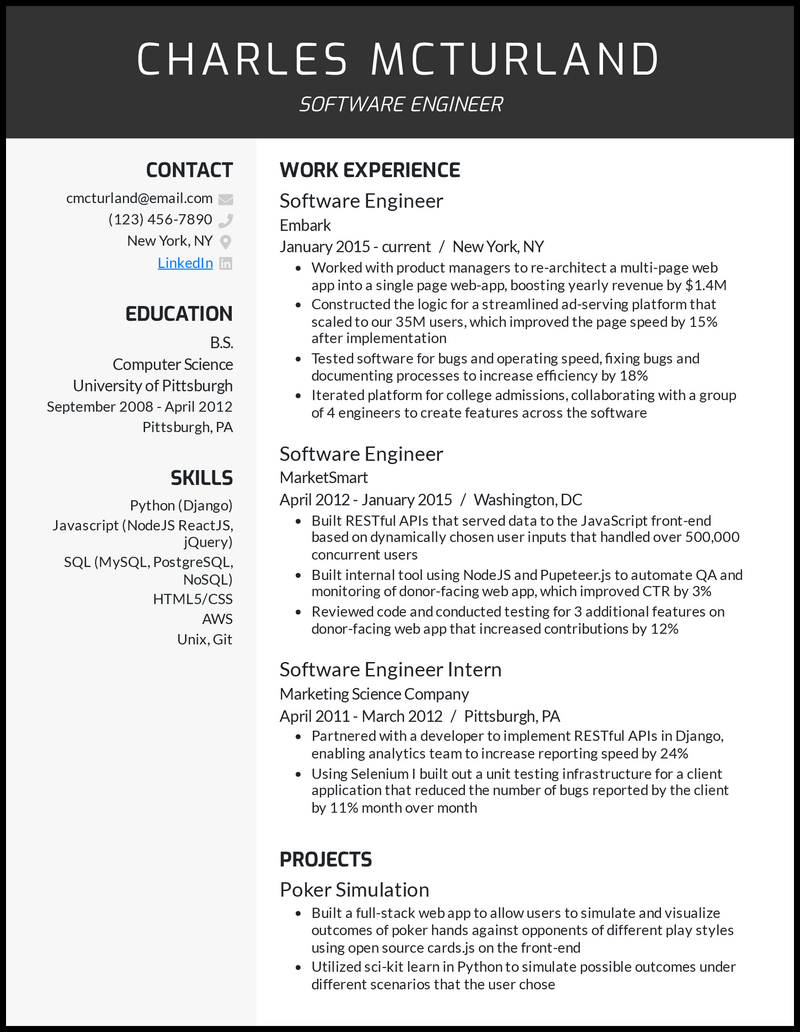
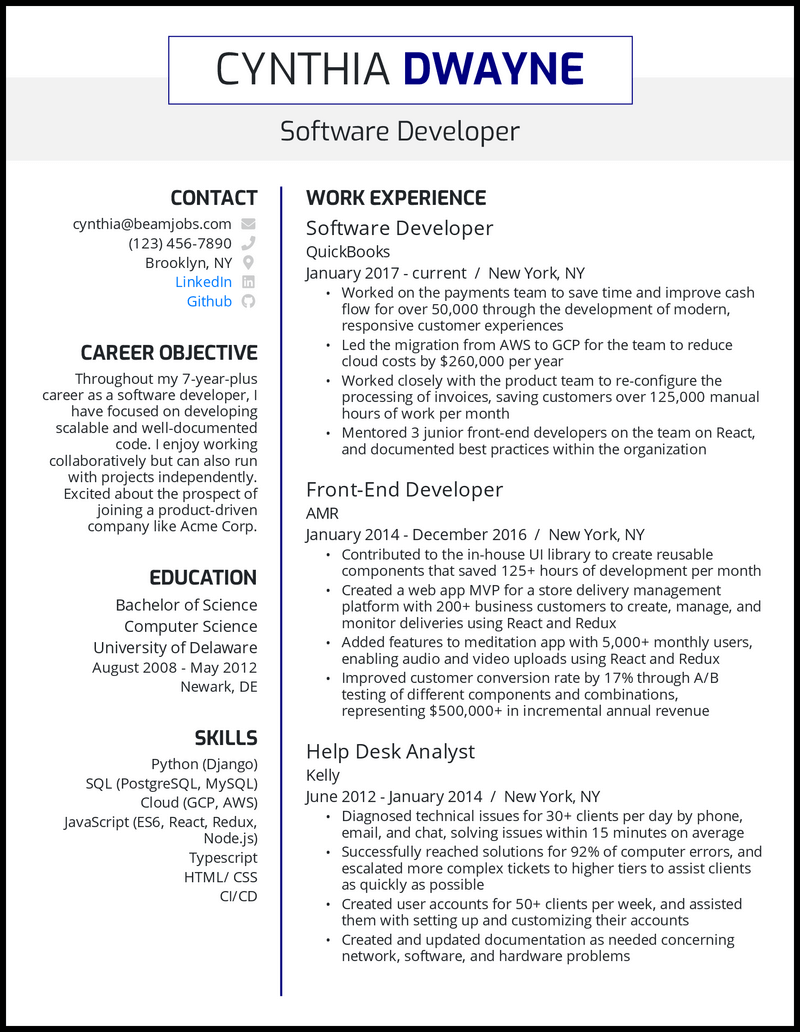

















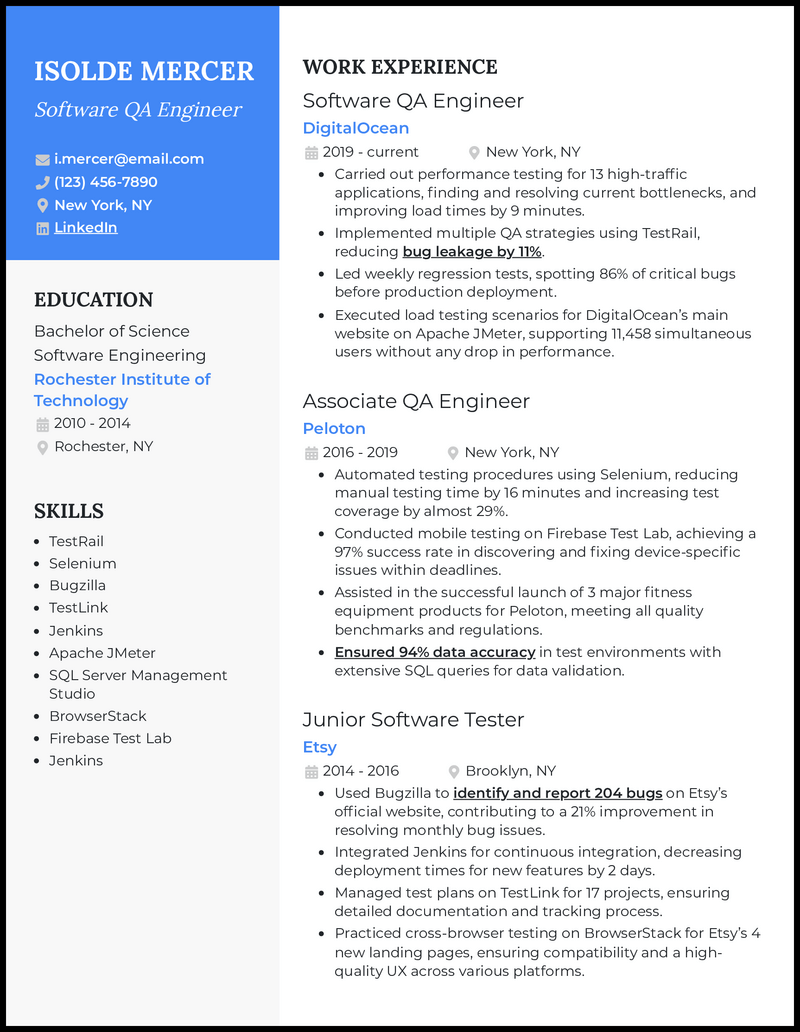

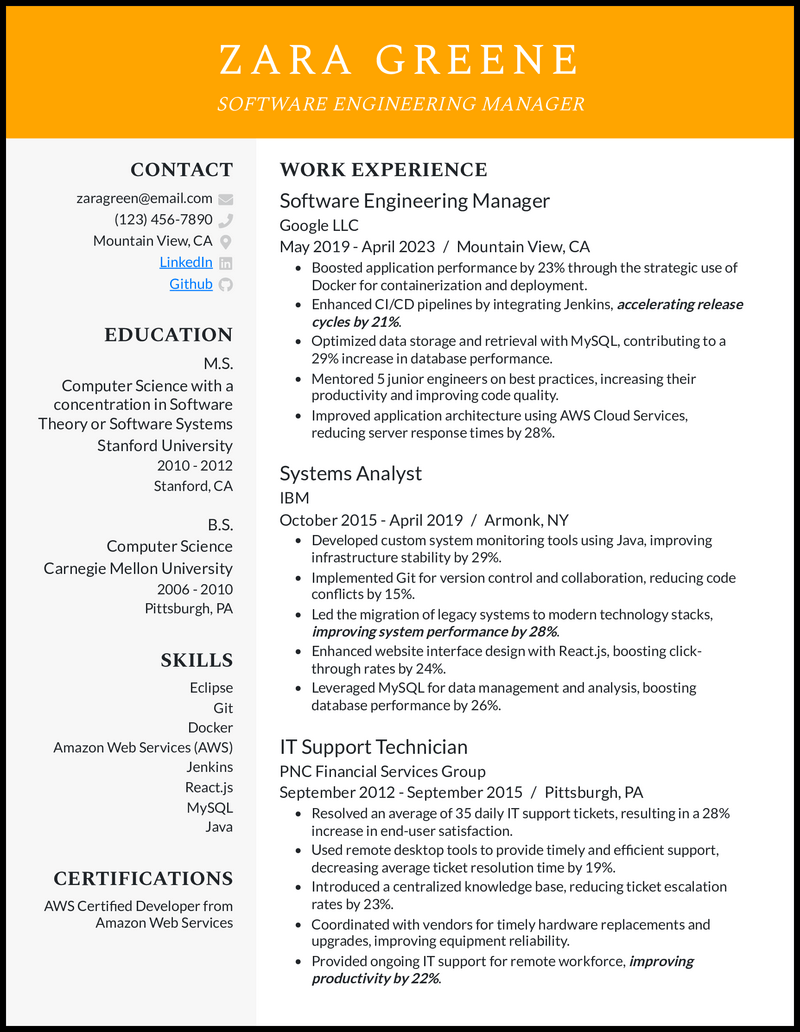


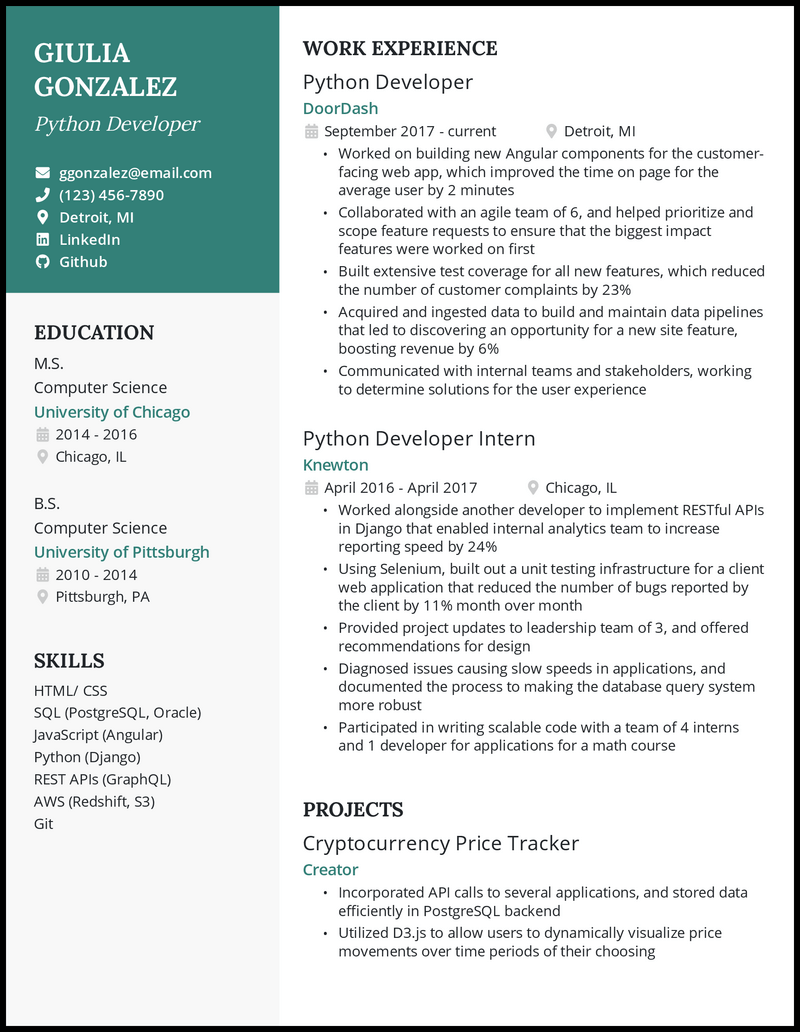








When you apply for an engineering job at a company, the first person looking at your resume is actually not a person. Companies use something called an Applicant Tracking System (ATS) to filter out a majority of applicants for a role based on keyword matching.
If you pass this initial scan, your resume will get reviewed by a non-technical recruiter. Then at long last, the technical hiring manager will look at your resume.
So, how do you write a resume that will get you through all these hoops to get that first interview? That’s what this guide is designed to help you do!
We’ve analyzed numerous resumes from software engineers and to come up with valuable resume tips to get your foot in the door.
Here’s what we’re going to cover in this guide:
![]()
The skills section is a vital part of your software engineer resume. This will make or break whether you get through the first phase of the resume review, aka the dreaded ATS scan.
Your resume’s skills section shouldn’t be a laundry list of frameworks and programming languages. Especially don’t try to include what you wouldn’t be comfortable coding; just reading about Java is not enough to have it in your skills section.
The worst thing that can happen is that you claim knowledge of a programming language and then can’t answer basic questions about that language in an interview. It’s much better to have true expertise in one programming language than to claim knowledge of 10 different languages.
Good hiring companies know that quality engineers can learn new frameworks as needed. So, it’s a big red flag if you list every programming language under the sun.
There are a few options for organizing your skills section on your resume. First, you can organize them by your proficiency level. You can use categorizations like “Advanced” vs. “Familiar” or “Expert” vs. “Working Knowledge.”

Or you can organize them by the type of skill you’re discussing. So you can separate the programming languages you know, the frameworks, the tools, and the databases you’ve used.

Finally, you can list the programming languages you know and include the frameworks associated with that language you’ve used. You can also list your years of experience with that language. This is useful for recruiters, but it can take up a lot of space on your resume, so make sure your resume format allows for an extended skills section.

![]()
Threading the needle of making your resume ATS-readable, HR-readable, and technical-hiring-manager-readable is not an easy task. So, try to quantify your achievements without getting too in the weeds (while also not being too broad).
The most important resume formatting tip that you should internalize is making your resume one page long, maximum. Recruiters spend, on average, only six seconds reviewing your resume. They’re not going to read a several-page resume.
Here are the quick hits for how to properly format your resume:
It’s tough to fit all of your projects and work accomplishments on a single page, but remember, you’re more than your resume. Recruiters understand this and know if a resume looks good initially, they can ask more questions in the interview.
Your goal with your resume isn’t just to include your best talking points; it’s also to make the life of the person reviewing it as easy as possible. Make sure you don’t have long paragraphs of text so it’s easier to read. Break up your would-be paragraphs into singular ideas that are more appealing to the reader.
Bad bullet point formatting
Designed and built out the backend for a client application that enabled users to build their own recipe books. Used Angular on the front-end and NodeJS on the back-end. Working closely with product managers, scaled this application to 200,000 users and generated annual revenue of $1.4M. (If you’re still reading this, then well done, because it’s far too long.)
Good bullet point formatting
Your bullet points should be self-contained, so you don’t need periods after each point. Within your bullet points, make sure your verb tenses are consistent (past tense is preferable).
Also, we’d recommend avoiding singular pronouns, so don’t use “I” or “we.” They waste time and look unprofessional, so don’t include them. For example, instead of saying, “I worked on building the back-end for a project,” you should say, “Worked on building the back-end for a project.” There are plenty of ways to avoid saying “I.”
Lastly, please review all grammar and spelling. Don’t give recruiters or hiring managers an easy excuse for someone to put you into the “no” pile. Too many great software engineers don’t check their resumes and leave typos and punctuation errors.
Your name should be the first thing on your resume, and it should be listed in a bigger font. Directly underneath it, you should include a title. This title should always be the job for which you’re applying. So, if your current title is “software engineer” and you’re applying for a senior engineering role, your title should be “senior software engineer.” After your title, include your contact information, including:
And although you know already to review your resume for typos, triple-check your contact section for anything that’s incorrect. We once had a great engineer misspell his email here, and although he was a great fit for the role to which he was applying, the company couldn’t contact him, so he didn’t get an interview!
This may seem like a lot of information to include, but you can make it compact. Here’s a great example:

![]()
What you include in the education section of your resume will vary depending on whether you’re applying for an entry-level software engineering role or a more senior role.
Regardless of your seniority, you should always include the school you attended, the year you graduated, and your major. If you had a minor or a specific concentration, include that.
If you’re applying for anything other than an entry-level role, that’s all you should include in your education section. Why? Because real estate is valuable on a resume, and your work experience and projects will convey more about your qualification than your GPA or college courses.
Suppose you’re applying for a software engineering internship or looking for your first full-time role. In that case, your education section will be more expansive to accurately convey your qualifications. Plus, you’ll want to mention relevant courses to the role for which you’re applying. For software engineering roles, this means any classes related to software engineering. Took a databases class? Completed an algorithm design course? You get the idea.
If you want to include your GPA, make sure it’s above a 3.2. Otherwise, leave it out.

VS
![]()
![]()
Unless it’s done exceptionally well, we strongly recommend that you don’t include a resume summary or objective on your software engineer resume. Why? Because they rarely, if ever, convey meaningful information to the person reviewing your resume. Let’s break down a typical objective statement:
I have 3+ years of experience, and I’m looking to leverage my Django expertise to work on challenging problems as a Senior Software Engineer.
There isn’t anything new in this objective. Their 3+ years of experienceand Django expertise should be demonstrated in their work experience. There’s no customization for the specific job, and it’s far too short.
Remember, recruiters typically only look at your resume for six seconds. Don’t make them waste precious time on anything that doesn’t demonstrate new information about why you’re a great fit for the role.
Anything unique to your situation or circumstance (for example, you’re undergoing a career change) should be discussed when creating a cover letter. You can elaborate on what you’re looking for in your next role without the constraint of space.
![]()
Your work experience section is, without a doubt, the most important section on your resume. This is where a resume reviewer spends most of their time and attention. It’s here that they’ll decide whether they want to move you onto the first stage of the interview process. So, this is not the place to be humble. Show off the good work you’ve done.
If you’re a junior developer, this section will be shorter (in favor of a longer “Projects” section). If you have two-plus years of work experience, this should take up the majority of the space on your resume.
So how do you talk about your work experience convincingly? The key is to be specific and quantify the impact of your work whenever possible.
Developers rarely work in complete isolation, especially at larger companies. So you must tease out what you did specifically on each project. If you worked as part of a team to turn a multi-page web app into a single-page app, and you were in charge of re-designing the back-end infrastructure for the new app, talk about that specifically.
Architected the new back-end in Ruby to change multi-page primary product into a single-page app, resulting in $1.2M in annual incremental revenue.
The team changed our primary product from a multi-page app to a single-page app, resulting in $1.2M in annual incremental revenue.
Notice that when talking about your actual work, you want to be specific about your particular role. However, when talking about the project’s impact, you can talk about the overall effect that the team had.
Again, quantify the impact of the projects you worked on whenever possible. Businesses hire engineers to move the company forward, and the best way to demonstrate you can do that is to show you’ve had a measurable impact in your past roles. Rough estimates of impact are okay if you don’t have exact numbers; just be reasonable and logical in your assessments.
Here are some other ways you can try to quantify your work:
The formula for discussing your work experience is “my specific contribution to a project” + “the overall quantitative impact.” This describes the same work experience, just in different ways.
Let’s look at an example of this in action to see how effective it is.


![]()
The size of your projects section on your software engineer resume should be directly tied to your seniority level when applying for a developer job. The more junior your role, the more space you should allocate to your projects.
If you have more than two years of experience, you should only list one project of which you’re especially proud. Most of your resume should be composed of what you did in your previous jobs.
Try to talk about your projects in the same way you would talk about your work experience. The goal of your projects is to demonstrate your technical skills in context. Show how you used a language or framework to build something that satiated your curiosity or solved a problem.
Your projects should give more color to your skills section. While it’s great to say you know Ruby, it’s even better to say how you built the back-end of your movie recommendation engine in Ruby. Anyone can list a skill on their resume, but showing how you used that skill demonstrates even stronger mastery of that skill.
If you worked on substantial coding projects during school, you should include them here. When possible, always include the projects you’ve listed on your resume in your Github profile or on your personal website.
Here’s the format of how you should talk about your projects on your resume:
Again, you’re trying to demonstrate two things to a hiring manager with your projects. First, you want to give context to the skills you list on your resume. Next, you want to show that you can identify a problem and then implement a solution to solve that problem.
![]()
If you have a bit of extra space and have a hobby or interest that might interest employers, you should include it. Some companies appreciate personality, so this would be the place to highlight that.
![]()
We know, we know; customizing your resume is tedious. But we have some good news! You don’t have to overhaul your resume for each job to which you apply. You will likely have to change one or two bullet points on your resume for each application.
Read the software engineer job description for the job to which you’re applying. Do any particular projects you’ve worked on or languages you’ve used come to mind when reading it? Those should absolutely be included in the resume you submit for that role.
Now, let’s say you’re applying for the following role:

Clearly, they want an engineer who has experience developing APIs. So, instead of just one bullet talking about my experience building out APIs, you should allocate two to three bullet points to my work.
When customizing your resume for each job you apply for, be sure to expand on the work experience or projects you’ve worked on that are especially relevant to the position at hand.
![]()
Here are the major takeaways you should keep in mind when writing a professional resume:
Remember, the goal of this resume is to get your foot in the door. Once you get that first phone interview, your skills and personality will surely shine through.
Applying to new jobs can be daunting, but one of the most complex and most confusing parts is now over. You’ve done the research, and you’re ready to write your resume! You can use our free AI resume builder to start your resume from scratch or a template, and our free resume checker uses AI-powered tips to suggest improvements and resolve errors.
You’ve got the knowledge; now go land your dream job!